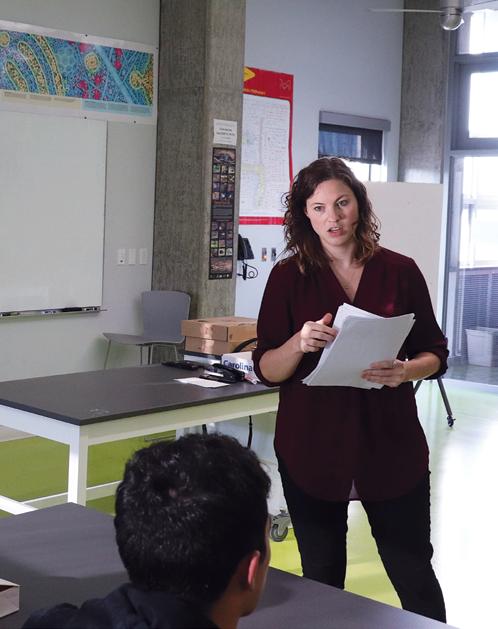
9 minute read
Remote Learning
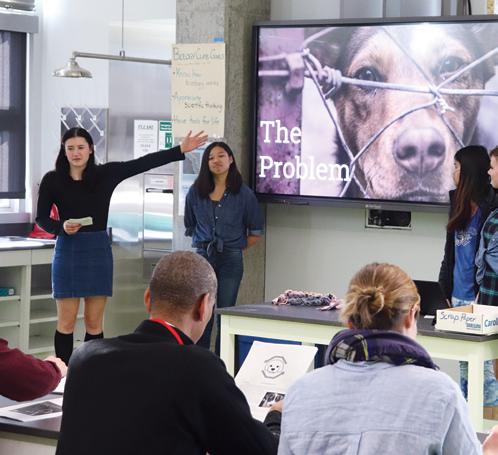
reading. We are continually looking for ways to instill empathy in students.
In addition, we think a lot about the importance of failure. How can we teach kids to be resilient? In the Innovations 10 course, Tom Flood, along with the school counselors, guides students through “resilience training,” where they talk about how they learn from failure and use it to improve. All 10th grade students, regardless of background, learn to use the tools in the shop in order to build a model of a tiny home. This is out of the comfort zone of most students, but it both encourages them to push themselves and lowers the barrier to entry for hands-on skills that some would never approach on their own.
Another pivotal example of teaching resilience comes from the Entrepreneurial Leadership course this year. Teachers Mariah Gentry ‘09 and Giselle Furlonge gave students a $2 Challenge. The task seemed simple: create as much value as you can with just $2 in a two-week period. Students struggled to grapple with the open-end- edness of the assignment, trying to find the “right answer.” There were tears at a few points in the process. But as the students started to discover that there was no right answer, the project quickly evolved into a personal journey. Each student determined the best answer given their unique values and circumstances. After several check-ins, many students began to notice that the greatest value was when they intention- ally did something for someone else.
The students traded their dollars or transformed them into artwork, bought items and sold them to siblings, traded services such as cleaning or cooking for a few dollars, created matching programs, invested in microloans for people around the world, and offered to help others. After two weeks, along with numerous treasures such as a pair of skis, vinyl records, origami creatures, and red pens, the class counted $671 from just $26 dollars. Most of that
money was donated to homeless people, Australian Wildfire Relief, and the IF Project. Even more impressive were the reflections by students who wrote about why they made each transaction, the value created, and the impact on others. One student pinned his final dollar to the wall as a reminder of his growth in the class. The $2 Challenge became a very personal example of empathy, value, and financial literacy under the umbrella of entrepreneurship. It ended up being a transformative experience.
An encouraging indicator that we are on the right track is the survey data collected from Senior Project Mentors in 2019. In the category of “ability to deal with failure,” ratings of 8/10 or 9/10 of SAAS students by Senior Project Mentors have risen to 94% . To us, this shows that focusing intentionally on teaching students how to rebound from failure has started to pay off, and we look forward to further improving in the area of resilience.
More broadly, there is ample opportunity for crossover from Computational Thinking, Financial Literacy, and Entrepreneurship to Science, History, or Debate classes. Our hope is that students in these required courses will develop a mental muscle memory and be able to apply problem-solving, resiliency, and design-thinking principles in other classes and activities. We think of it as a booster pack of courses that can unlock creativity and innovation in everything students do in their busy lives.
At a time when employers are telling us that they want hard and soft skills, and when we can’t predict the jobs that our students will hold in their lifetimes,

Upper School students in Tom Hajduk’s class visit the new Amazon Go store.
we would be doing kids a disservice if we just focused on which programming languages to teach. Whatever the hot new language is now will surely be different in the future. Instead, we are thinking about how to develop resilience, critical thinking, empathy, persistence, and problem-solving. At SAAS, our Guiding Principles lead us to nurture talents born, talents made, and talents discovered, to prepare kids for College and Life. At the end of the day, the school’s mission rings loudly in our ears: “we challenge students to question, imagine, and create in order to contribute boldly to a changing world.” ☜
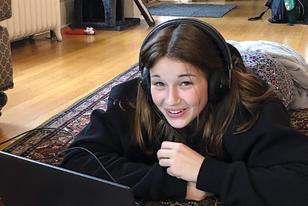
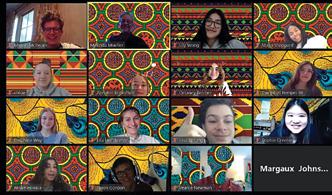
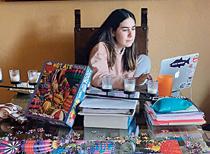
ROB PHILLIPS, HEAD OF SCHOOL
As our small boat approached the remote Alaskan shoreline, it began to dawn on me how dramatically my world was about to change. I had flown from Seattle to Alaska earlier that day, acting on a plan I’d had for years to live with my aunt and uncle at their remote homestead. But reality wasn’t following my plan.
Rather than head from the airport to the homestead, my uncle redirected the boat in the opposite direction. We travelled to an isolated coastline filled with drift logs, and his goal was to raft as many up as we could gather, and tow them back to the homestead while the winds and tide were favorable.
He eased the boat into a remote bay, handed me a long, pointed stick with a sharp iron end that looked a lot to me like a medieval weapon, pointed to the chest deep water, and said “Jump out. You’re going to wade around those logs, grab them with the pole, and push them out in the bay so I can raft them up.”
I looked at him in disbelief, then said, “That’s a terrible plan. It’s getting dark, the water is cold, and you want me to jump into the ocean? That is definitely NOT a good idea.”
My uncle paused for a second, looked away, and then looked me straight in the eyes and said, “Nephew, look around you. This is the real Alaska, not the one in your head. For starters, throw away everything you think you know about what constitutes a good idea. Now jump out of the boat and get to work. Time is not on our side.”
As schools nationwide have grappled with the onset of Covid-19 and the necessity of online learning, we’ve had to take my uncle’s advice.
Necessity has forced us to reconsider our previous assumptions. And we’ve all had to jump out of the boat and get to work.
As a nation, we need to take collective responsibility for how unprepared we were for this crisis. Teaching and learning remotely is dramatically different from being in a classroom. And yes, there are major problems to solve—such as ensuring computer and internet access—if we’re going to do it well in the moment and for the long haul. We need an Educational Marshall Plan to address equity issues in our schools and in our communities.
There is no getting around the fact that this wasn’t the education we planned for our students, and it’s certainly not the education they deserve. But we can’t lose sight of the fact that by demonstrating creativity and resilience, educators and students are building community in new ways and teaching us all important lessons.
What are we learning in Seattle, six weeks after we made the decision to go online? We’re learning that students respond when we communicate with them in ways that convey honesty, trust, respect, and support.
At Seattle Academy, we’ve always believed that relationships precede achievement. We were one of the first schools in the country to close our physical doors and move online in early March, and my communication to students began by validating their frustration, disappointment, adaptability, and resilience:
You get to be disappointed, you get to be angry, and you get to flat out be really bummed about this. I am all of those right now too, and will be for a long time. But that doesn’t mean we should let this crisis define us. The legacy of the class of 2020 is going to be the senior class that provided leadership in a tough time.

We’re learning that schools can and should attend not only to providing curriculum online, but also to building a sense of community. One of the challenges of the current situation is that it has the potential to increase our sense of isolation at a time when we most need connection. So much about this crisis is powerfully disconcerting, but there's also a lot that is reaffirm- ing about what it means to be a community.
To that end, we’ve dedicated a full day each week to combating isolation and separation. Wednesdays are given over to community town halls, class meetings, advisory, and home room, as well as student talent shows, online clubs, affinity groups, and group chats. While it is a loss of instructional time, effective teaching and learning is built on relationships and connections, and those must still be present.
We’re learning that students and teachers are more agile than we give them credit for. They are working hard, trying new things, and demonstrating agility and curiosity in abundance. Older students have organized tutoring groups for younger students. They have found online internships, engaging in civic action and community service. Students of all ages have given teachers the feedback they need to learn to teach in a new context.
For their part, teachers have turned garages into chemistry labs, moved biology lessons to their backyards, and engaged students in creating podcasts, editorials, and letters to political leaders.
The result? In Seattle, we’re finding that students are responding to online learning with an admirable level of flexibility and resolve.
Ironically, in many ways the students are the ones teaching those traits to us. They are showing us an ability to plan and pivot, to act and adjust, and to balance the needs of the individ- ual with the health and sustainability of the whole community.
They’re forcing us to reconsider our assumptions, and they haven’t been afraid to jump out of the boat and get to work. But as my uncle said, “time is not on our side.” We’ll face these challenges again, sooner than we might want to admit. ☜

Seattle Academy Timeline for Closures, Cancellations, and Remote Learning Adjustments
MID-FEBRUARY Tracking of various agencies regarding COVID-19
MARCH 1 Cancellation of Seattle Challenge and End-of-Trimester Performances
MARCH 5 Guidelines for Cancellation of Events: No events over 100 people, No Outside Guests/Speakers, No Field Trips, No Accreditation Visits, No Domestic or International Trips
MARCH 6 Announcement of extended closure through Spring Break and remote learning
MARCH 10–11 Families pick up books and supplies as well as items in lockers
MARCH 12 Remote learning begins
MARCH 23 Announcement of updated schedule including We Wednesday
MARCH 30 Implementation of New Schedule and We Wednesday










